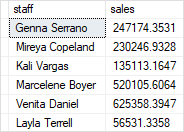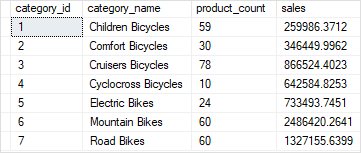Summary: in this tutorial, you will learn about the common table expression or CTE in SQL Server by using the WITH clause.
Introduction to CTE in SQL Server
CTE stands for common table expression. A CTE allows you to define a temporary named result set that available temporarily in the execution scope of a statement such as SELECT, INSERT, UPDATE, DELETE, or MERGE.
The following shows the common syntax of a CTE in SQL Server:
WITH expression_name[(column_name [,...])]
AS
(CTE_definition)
SQL_statement;
Code language: SQL (Structured Query Language) (sql)In this syntax:
- First, specify the expression name (
expression_name) to which you can refer later in a query. - Next, specify a list of comma-separated columns after the expression_name. The number of columns must be the same as the number of columns defined in the
CTE_definition. - Then, use the AS keyword after the expression name or column list if the column list is specified.
- After, define a
SELECTstatement whose result set populates the common table expression. - Finally, refer to the common table expression in a query (
SQL_statement) such asSELECT,INSERT,UPDATE,DELETE, orMERGE.
We prefer to use common table expressions rather than to use subqueries because common table expressions are more readable. We also use CTE in the queries that contain analytic functions (or window functions)
SQL Server CTE examples
Let’s take some examples of using common table expressions.
A) Simple SQL Server CTE example
This query uses a CTE to return the sales amounts by sales staffs in 2018:
WITH cte_sales_amounts (staff, sales, year) AS (
SELECT
first_name + ' ' + last_name,
SUM(quantity * list_price * (1 - discount)),
YEAR(order_date)
FROM
sales.orders o
INNER JOIN sales.order_items i ON i.order_id = o.order_id
INNER JOIN sales.staffs s ON s.staff_id = o.staff_id
GROUP BY
first_name + ' ' + last_name,
year(order_date)
)
SELECT
staff,
sales
FROM
cte_sales_amounts
WHERE
year = 2018;
Code language: SQL (Structured Query Language) (sql)The following picture shows the result set:

In this example:
- First, we defined
cte_sales_amountsas the name of the common table expression. the CTE returns a result that that consists of three columnsstaff,year, andsalesderived from the definition query. - Second, we constructed a query that returns the total sales amount by sales staff and year by querying data from the
orders,order_itemsandstaffstables. - Third, we referred to the CTE in the outer query and select only the rows whose year are 2018.
Noted that this example is solely for the demonstration purpose to help you gradually understand how common table expressions work. There is a more optimal way to achieve the result without using CTE.
B) Using a common table expression to make report averages based on counts
This example uses the CTE to return the average number of sales orders in 2018 for all sales staffs.
WITH cte_sales AS (
SELECT
staff_id,
COUNT(*) order_count
FROM
sales.orders
WHERE
YEAR(order_date) = 2018
GROUP BY
staff_id
)
SELECT
AVG(order_count) average_orders_by_staff
FROM
cte_sales;
Code language: SQL (Structured Query Language) (sql)Here is the output:
average_orders_by_staff
-----------------------
48
(1 row affected)
Code language: SQL (Structured Query Language) (sql)In this example:
First, we used cte_sales as the name of the common table expression. We skipped the column list of the CTE so it is derived from the CTE definition statement. In this example, it includes staff_id and order_count columns.
Second, we use the following query to define the result set that populates the common table expression cte_sales. The query returns the number of orders in 2018 by sales staff.
SELECT
staff_id,
COUNT(*) order_count
FROM
sales.orders
WHERE
YEAR(order_date) = 2018
GROUP BY
staff_id;
Code language: SQL (Structured Query Language) (sql)Third, we refer to the cte_sales in the outer statement and use the AVG() function to get the average sales order by all staffs.
SELECT
AVG(order_count) average_orders_by_staff
FROM
cte_sales;
Code language: SQL (Structured Query Language) (sql)C) Using multiple SQL Server CTE in a single query example
The following example uses two CTE cte_category_counts and cte_category_sales to return the number of the products and sales for each product category. The outer query joins two CTEs using the category_id column.
WITH cte_category_counts (
category_id,
category_name,
product_count
)
AS (
SELECT
c.category_id,
c.category_name,
COUNT(p.product_id)
FROM
production.products p
INNER JOIN production.categories c
ON c.category_id = p.category_id
GROUP BY
c.category_id,
c.category_name
),
cte_category_sales(category_id, sales) AS (
SELECT
p.category_id,
SUM(i.quantity * i.list_price * (1 - i.discount))
FROM
sales.order_items i
INNER JOIN production.products p
ON p.product_id = i.product_id
INNER JOIN sales.orders o
ON o.order_id = i.order_id
WHERE order_status = 4 -- completed
GROUP BY
p.category_id
)
SELECT
c.category_id,
c.category_name,
c.product_count,
s.sales
FROM
cte_category_counts c
INNER JOIN cte_category_sales s
ON s.category_id = c.category_id
ORDER BY
c.category_name;
Code language: SQL (Structured Query Language) (sql)Here is the result set:

In this tutorial, you have learned how to use common table expressions or CTE in SQL Server to construct complex queries in an easy-to-understand manner.